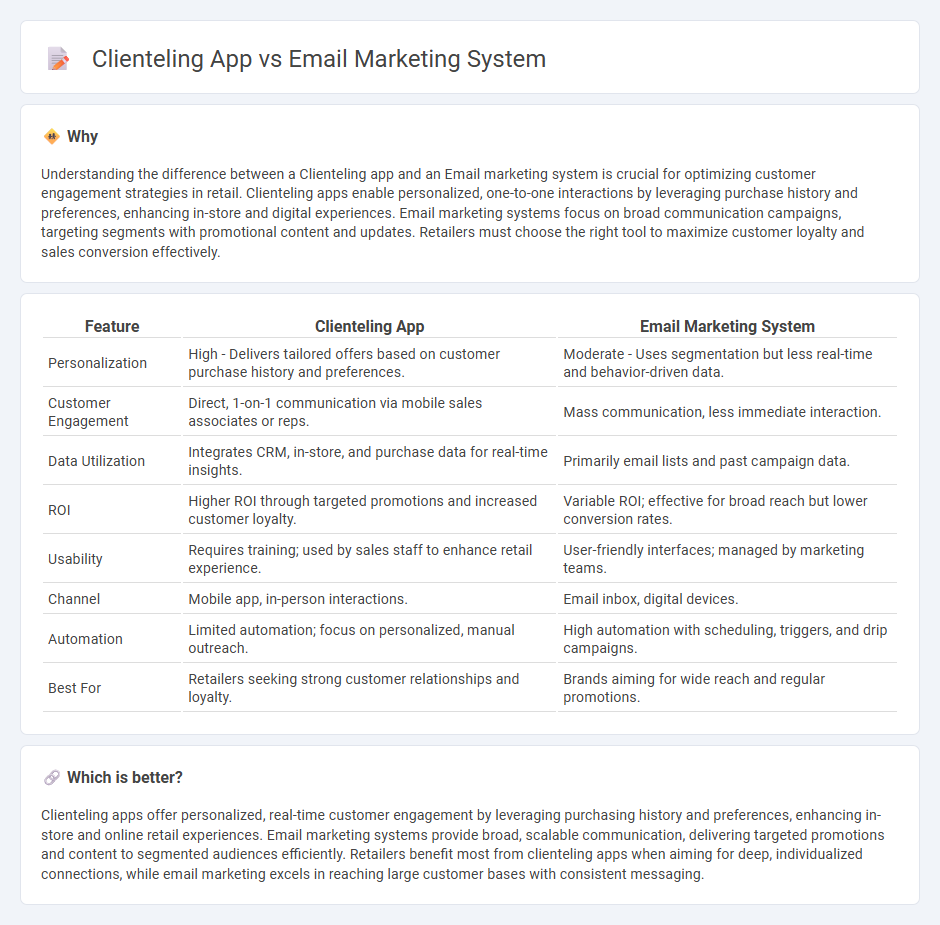
Clienteling apps leverage customer data to provide personalized shopping experiences, increasing loyalty and sales through targeted recommendations and real-time communication. Email marketing systems focus on mass outreach by delivering promotions and newsletters, often facing challenges with engagement and personalization. Discover how combining clienteling apps with email marketing can optimize retail customer relationships and drive growth.
Why it is important
Understanding the difference between a Clienteling app and an Email marketing system is crucial for optimizing customer engagement strategies in retail. Clienteling apps enable personalized, one-to-one interactions by leveraging purchase history and preferences, enhancing in-store and digital experiences. Email marketing systems focus on broad communication campaigns, targeting segments with promotional content and updates. Retailers must choose the right tool to maximize customer loyalty and sales conversion effectively.
Comparison Table
| Feature | Clienteling App | Email Marketing System |
|---|---|---|
| Personalization | High - Delivers tailored offers based on customer purchase history and preferences. | Moderate - Uses segmentation but less real-time and behavior-driven data. |
| Customer Engagement | Direct, 1-on-1 communication via mobile sales associates or reps. | Mass communication, less immediate interaction. |
| Data Utilization | Integrates CRM, in-store, and purchase data for real-time insights. | Primarily email lists and past campaign data. |
| ROI | Higher ROI through targeted promotions and increased customer loyalty. | Variable ROI; effective for broad reach but lower conversion rates. |
| Usability | Requires training; used by sales staff to enhance retail experience. | User-friendly interfaces; managed by marketing teams. |
| Channel | Mobile app, in-person interactions. | Email inbox, digital devices. |
| Automation | Limited automation; focus on personalized, manual outreach. | High automation with scheduling, triggers, and drip campaigns. |
| Best For | Retailers seeking strong customer relationships and loyalty. | Brands aiming for wide reach and regular promotions. |
Which is better?
Clienteling apps offer personalized, real-time customer engagement by leveraging purchasing history and preferences, enhancing in-store and online retail experiences. Email marketing systems provide broad, scalable communication, delivering targeted promotions and content to segmented audiences efficiently. Retailers benefit most from clienteling apps when aiming for deep, individualized connections, while email marketing excels in reaching large customer bases with consistent messaging.
Connection
A Clienteling app enhances personalized customer interactions by collecting real-time purchase data, which integrates seamlessly with an Email marketing system to deliver targeted promotions and product recommendations. This connection boosts customer retention and increases sales through tailored email campaigns based on individual shopping behavior and preferences. Leveraging CRM data from the Clienteling app enables marketers to segment their audience precisely and automate email workflows for maximum engagement.
Key Terms
Source and External Links
SendX - Email Marketing Software - SendX offers an all-in-one email marketing system with unlimited email campaigns, advanced automation workflows via drag-and-drop editor, personalized segmentation, and proprietary deliverability features to maximize open rates and engagement for over 3,000 businesses.
Mailchimp: Marketing, Automation & Email Platform - Mailchimp is a leading email marketing and automation platform integrating AI-driven content creation, SMS campaigns, segmentation, and comprehensive analytics to help businesses convert more customers and build long-lasting relationships.
8 Free & Cheap Email Marketing Software Tools 2025 - This resource compares various email marketing systems, detailing both simple tools for newsletters and sales promotions and advanced marketing automation software capable of building complex workflows, tagging subscribers, and triggering personalized campaigns.
 dowidth.com
dowidth.com